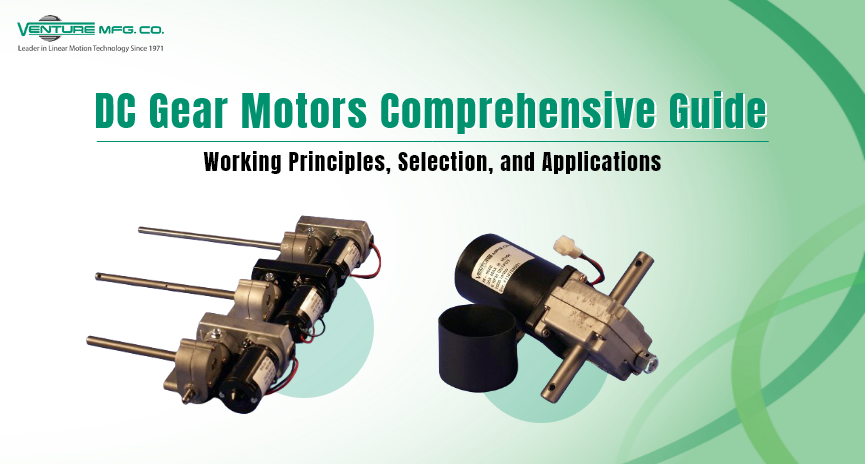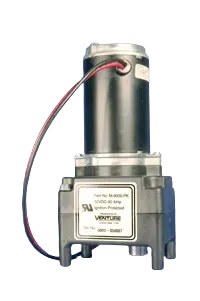
What are DC Gear Motors?

A DC gear motor combines a direct current (DC) motor with a gearbox, which helps create smooth, precisely-controllable motion without consuming excessive power. The gearbox is attached to the motor’s output shaft, modifying the motor’s speed and torque to meet specific application requirements. Combining the remarkable power of DC motors with the mechanical advantage of gearboxes, they find immense applications in robotics, automotive systems, and industrial machinery, among others.
DC Gear Motor Working Principle
A DC gear motor works on the principle of electromagnetic induction. These units, by combining a DC motor with a gearbox, are known to offer high torque at low speeds. When direct current (DC) is applied to the motor – which is the primary workhorse – it forms a magnetic field that interacts with the armature, leading it to rotate. This rotational motion is then transferred to a series of gears within the gearbox – often referred to as a reduction gear. This process reduces the motor’s speed while increasing its torque. In other words, the function of gearbox here is to regulate the speed of the motor as per the needs of your applications. The gear reduction significantly enables the motor to offer force at controlled, lower speeds.
Benefits of DC Gear Motors
Extensively used in light, medium, and heavy-duty processes, DC gear motors are known for their following benefits.
- As gear reduction mechanisms increase torque output, DC gear motors are highly suitable for applications requiring substantial force at low rotational speeds.
- Owing to their adaptable design, these units find application across sectors including robotics, automotive systems, industrial automation, and medical devices.
- They are known for their high efficiency in converting electrical energy to mechanical power with minimal losses.
- DC gear motors are ideal for installations with limited space. Thanks to their compactness due to the integration of a gearbox with the motor.
- They allow for seamless integration with existing control systems and microcontrollers, due to their straightforward electrical control interfaces.
- Users can expect a fine-tuned motor performance out of these gear motors. Thanks to their speed regulation through voltage adjustment and pulse-width modulation (PWM).
- As these units are available in diverse gear ratios, they allow for tailored speed and torque configurations ideas for different application requirements.
- They incorporate features to minimize operational noise and vibration.
- They are designed with efficient heat dissipation, which enables easy handling of high-power loads without overheating.
Factors to Consider When Selecting DC Gear Motor
When selecting DC gear motors, some notable factors must be considered to ensure the motor meets the specific application requirements. A few of them include:
- Torque/Speed: Analyze the necessary torque and speed requirements for your application. Consider both starting and running torque, and choose a model wisely.
- Voltage and Current: Ensure that the motor’s voltage and current specifications properly match your power supply and control system.
- Size: Check the motor’s physical dimensions and mounting configuration. Ensure that the model you have chosen fits well within the space constraints of your application.
- Customization: Check whether the model allows for any customizations such as specific gear ratios, shaft configurations, or mounting options.
- Noise/Vibration: Check the acceptable noise and vibration levels for your application and invest on a model accordingly. This is especially important in noise-sensitive environments.
- Load: Understand the type of load the motor will drive. Check for any variations in load over time. Understanding these ensure a smooth performance.
- Duty Cycle: Check how often and for how long the motor will be running. Continuous, intermittent, or variable duty cycles will affect motor selection. Also, it is important to choose an efficient motor to minimize energy consumption and heat generation.
- Environmental Conditions: Assess the operating environment, including temperature, humidity, exposure to dust or chemicals, and the need for waterproof or dustproof designs.
- Compliance and Standards: Choose a model that complies with relevant industry standards and certifications, such as CE, UL, or RoHS.
Application Areas
Applications of DC gear motors are endless. A few of their application examples include:
- Automotive: They find applications in seat adjustments, sunroof mechanisms, windshield wiper, and power windows.
- Industries: Conveyor belts, packaging machinery, and automated assembly lines are some of the areas where DC gear motors find their applications.
- Robotics: They guarantee the smooth and effortless functioning of robotic arms and grippers, drones and UAVs, servo mechanisms, among others.
- Consumer Electronics and Appliances: Electric toothbrushes, vacuum cleaners, electric shavers are some of the application examples of gear motors in the electronics sector.
- HVAC Systems: They are used to make actuators for damper control, variable air volume units, and motorized valves, among others.
- Medical: They play a critical role in the functioning of powered surgical tools, infusion pumps, prosthetic limbs, and so on.
Enjoyed this post? Read more in our related blog: Why DC Gear Motors are Ideal for Precision Motion Applications.
Overall, with an appropriate motor and gearbox combination, you can expect the speed and efficiency to virtually any precision motion requirement. Combining the robust power of DC motors with the mechanical advantage of gearboxes, DC gear motors from Venture Mfg. Co. contribute to providing an excellent range of power and speed required to power various devices and appliances. Get in touch with the team at sales@venturemfgco.com or call us at (937) 233-8792 and choose the right model that serves your purpose the most.
